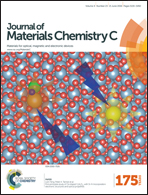Tailorable perylene-loaded fluorescent nanostructures: a multifaceted approach enabling their application in white hybrid LEDs†
Abstract
Organizing materials into well-defined nanostructures by self-assembly is of great interest for manufacturing various photonic devices at limited costs. In this study, we report on a versatile strategy to mold a perylene-containing building block into different fluorescent nanometric objects from zero- to two-dimensional shapes: particles, fibers and honeycomb films. As a practical example of application of these nanostructures into a functional device, we make use of fluorescent electrospun fibers to develop an efficient and stable white hybrid LED. The straightforward approach consists of the encapsulation of the nanofibers, used as downconversion materials, in flexible elastomeric semitransparent discs, which are then applied on a blue GaN LED. The main advantages include the ease of nanofiber manipulation and assembling of the final device, flexibility/stretchability of the downconversion filter, and practical tuning of the color temperature and rendering by simply adjusting the composition and number of discs, allowing us to obtain white light with chromaticity coordinates (0.36, 0.35), a correlated color temperature of 4500 K and a power efficacy as high as 70 lm W−1. In addition to the benefits above, the promising stability values shown by the device make our nanofiber approach a good option for the fabrication of downconversion filters for solid state lighting purposes.


 Please wait while we load your content...
Please wait while we load your content...